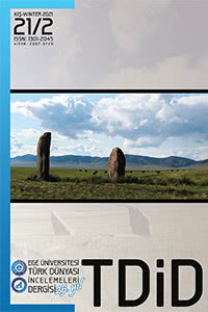XVIII. ve XIX. Yüzyıl BatılıSeyyahlara Göre Karaçay-Malkar Etnogenezi
The Karachay-Balkar Ethnogenesis through the Eyes of Western Voyagersin the 18th and 19th Centuries
___
- ADİLOĞLU Adilhan, "Eski Avrupa ve Rus Yazılı Kaynaklarına göre Karaçay-Malkar Türkleri", https://ko-kr.facebook.com/note.php?note_id= 10150274032145438, Erişim 24 Ekim 2014.
- BARTHOLD V.V. [2004]. Rusya ve Avrupa'da Oryantalizm, Çev. K. Bayraktar- A. Meral, İstanbul: Küre Yay.
- CHARDIN Jean [2014]. Chardin Seyahatnamesi 1671-1673, Ed. S. Yerasimos, Çev. Ayşe Meral, İstanbul: Kitap Yayınevi.
- ELLIS George [1788]. Memoir of a map of the countries comprehended between the Black sea and the Caspian, Londra.
- ERKAN Aydın O. [1999]. Tarih Boyunca Kafkasya, Çiviyazıları, İstanbul.
- FRESHFIELD Douglas W. [1902]. The Exploration of the Caucasus, vol. I-II, Londra.
- FRESHFIELD Douglas W. [1869]. Travels in the Central Caucasus and Bashan, Longmans Green, Lond- ra.
- GOLOVIN Ivan [1854]. The Caucasus, Trübner Company, Londra.
- GROVE F.C. [1875]. The Frosty Caucasus, Longmans Green and Co., Londra.
- GUMİLEV Lev N. [2004]. Etnogenez: Halkların Şekillenişi, Yükseliş ve Düşüşleri, Çev. D. Ahsen Batur, İstanbul: Selenge Yay.
- KARATAŞ, Ömer; IŞIK Serdar [2015]. "Seyahatnamelerde Kuzey Kafkasya Türkleri", Celal Bayar Üniver- sitesi Sosyal Bilimler Dergisi, Cilt 13, Sayı 1, Manisa 2015, s.373-390.
- KLAPROTH Julius von [1814]. Travels in the Caucasus and Georgia, Londra.
- LAJOS Tardy [1977]. "Johannes De Galonifontibus 1404", Evi utibesza-moloja a Kaukazusi nepekrol, Antik Tanulmanvok (Studia Antiqua), XXIV. N 1-2, Budapest 1977, s. 91-123.
- LAJOS Tardy [1978] "The Caucasian Peoples and their neighbours in 1404", Acta Orientalia, 32 (1), Budapest 1978, s. 83-111.
- LAMBERTİ Arcangelo [1654]. Relatione della Colchide hoggi detta Mengrelia, nella quale si tratta dell'origine, costumi e cose naturali di quei paesi, Napoli.
- LYALL Robert [1825]. Travels in Russia, the Krimea, the Caucasus and Georgia, vol. I-II, Londra 1825.
- MİZİYEV İsmail [1998]. "İstoriya Karaçaevo Balkarskogo Naroda s Drevneyşih Vremen do Prisoedine- niya k Rossi", Çev. Aliy Şidakov, As-Alan, n.1, 1998, s.85. http://miziev.ru/work/kara-ay-malkar- halkinin-tarihi? showall=&start=6, erişim tarihi 27 Ekim 2014.
- PORTER Robert Ker [1821]. Travels in Georgia, Persia, Armenia, Ancient Babylonia &c., vol. I, Londra.
- POTOCKI Jan [1802]. Histoire Primitive des Peuples de la Russie avec une Exposition complete de Toutes les Nations, Imprime a l'Academie Imperiale des Sciences, St. Petersbourg 1802.
- POTOCKI Jan [1829]. Voyage dans les steppes d'Astrakhan et du Caucase, Paris.
- REINEGGS Jacop [1797]. Allegemie Historich, Topographische Beschreibung des Kaukasus, Hildesheim- St. Petersburg 1797. Russia through the Eyes of Foreigners: Travel and Personel Accounts from the Sixteenth Century to the October Revolution 1917, Leiden: IDC Publishers.
- SİDORKO Clemens P. [2002]. "Nineteenth century German travelogues as sources on the history of Daghestan and Chechnya", Central Asian Survey, 21 (3), 2002, ss. 283-299.
- SPENCER Edmund [1837-1839]. Travels in Circassia, Krım Tartary v. I-II, Henry Colburn, Greast Marlbo- rough Street, London.
- SPENCER Edmund [1855]. Turkey, Russia, the Black Sea, and Circassia, George Routledge&Co., Lon- don.
- ŞAMANLANI İbrahim [1987]. Koban Başında-Tarih Haparla, Çerkessk.
- TAVKUL Ufuk [2007]. Kafkasya Gerçeği, İstanbul: Selenge Yay.
- TORNAU Feodor Feodoroviç [1999]. Bir Rus Subayının Kafkasya Anıları, Çev. Keriman Vurdem, Ankara: Kafkasya Derneği Yay.
- WALLERSTEIN Immanuel [2011]. The Modern World-System II: Mercantilism and the Consolidation of the European World-Economy 1600-1750, Berkeley: University of Colifornia Press.
- ISSN: 1301-2045
- Yayın Aralığı: 2
- Başlangıç: 1996
- Yayıncı: Ege Üniversitesi Türk Dünyası Araştırmaları Enstitüsü
Azerbaycan'da Apşeron Savunma Yapıları
Bitmeyen Bir Tartışmaya Edebiyatçıların Bakışı: "Dil Öğretiminde Gramere Lüzum Var mı?"
Yrd. Doç. Dr. Emine Bilgehan TÜRK
Türk Dünyası İncelemeleri Dergisi/Journal of Turkish World Studies 16/1 Yaz-Summer 2016
Ahıska Türkleri: Bitmeyen Bir Göç Hikâyesi
"Ancak" ve "Yalnız" Kelimeleri Üzerine
Doç. Dr. Arzu Sema ERTANE BAYDAR
20. Yılında Türk Dünyası İncelemeleri Dergisi
Araş. Gör. Ali BALCI, Araş. Gör. Gökçe EMEÇ, Araş. Gör. Umut ÜREN
Kazak Halk Edebiyatında Bir Mizah Kahramanı Olarak Aldar Köse
Dr. Erdal ADAY, Kanat MOLDATAYEV
Fâik Âli Ozansoy'un Neşredilmemiş Şiirleri
Yrd. Doç. Dr. Selahattin ÇİTÇİ, Doç. Dr. Sinan ÇİTÇİ
XVIII. ve XIX. Yüzyıl BatılıSeyyahlara Göre Karaçay-Malkar Etnogenezi
